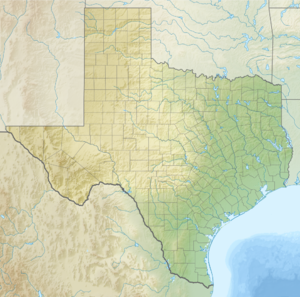Battle of Pease River
| "Battle of Pease River" | |||||||
|---|---|---|---|---|---|---|---|
| Part of the American Indian Wars | |||||||
|
|||||||
| Belligerents | |||||||
|
|
Comanche Noconi Band | ||||||
| Commanders and leaders | |||||||
| Sul Ross | None. Peta Nocona reported killed by Sul Ross, but this is strongly denied by his son Quanah Parker | ||||||
| Strength | |||||||
| 60 men | Unknown, but the best guesses are 20 in the band, including 16 unarmed Comanche women and 2 children | ||||||
| Casualties and losses | |||||||
| 3 reported. | All but three killed; Cynthia Parker was captured with her infant daughter | ||||||
|
|
|||||||
The Battle of Pease River occurred on December 18, 1860, near the present-day town of Margaret, Texas in Foard County, Texas, United States. The town is located between Crowell and Vernon within sight of the Medicine Mounds just outside present-day Quanah, Texas. A monument on that spot marks the site of the battle between a group of Comanche Indians (mostly women and children) and a detachment of Texas Rangers and militia under Ranger Captain "Sul" Ross. The Indian camp was attacked as retaliation against recent Comanche attacks on white settlers.
This raid is primarily remembered as the place where Cynthia Ann Parker was rescued from the Comanche she had lived with for 24 years.
Cynthia Ann Parker was a woman of European descent who had been kidnapped as a child by the Comanche in the Fort Parker massacre in 1836. The nine-year-old Parker had grown up among the Comanche, who called her “Nadua”. She had married war chief Peta Nocona and borne him 3 children. Nonetheless, the Rangers and her family had never given up hope of regaining her, though it is doubtful they realized until her recapture how thoroughly she had become Comanche. Her uncle, James Parker, had spent most of his adult life, and his fortune, in a fruitless search for her.
Her presence and recapture at Pease River was a matter of national importance, probably because, as Ross was quoted as saying in the book Indian Depredations, by J.W. Wilbarger, "Most families on the frontier had lost someone to the Indians. Cynthia Ann's recovery would be looked at as almost a miracle by those folks." The famous picture of her with her daughter Topsanah at her breast was carried in almost every paper in the country.
The greatly feared Comanche war chief Peta Nocona was a son of a chief of the Quahadi band of the Comanche known as the Wanderer, or possibly wanderer as in "outcast", or "he who wanders far and returns". Peta Nocona was one of the war chiefs present at the attack on Fort Parker, and had formed his own band of the Comanche called the Nokoni. They occupied territory along the Red River. Nocona had taken Cynthia Ann Parker as his wife a few years after she was captured by the Indians in 1836. A great tribute to his affection to her was that he never took another wife, though it was common among the Comanche for such a successful war chief to do so. The couple eventually had two sons, Quanah Parker and Pecos, and a daughter, Topsannah.
...
Wikipedia

